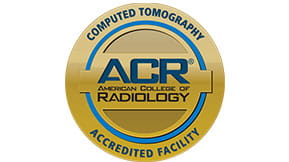UPMC Hillman Cancer Center is part of the UPMC family.

PET-CT Portal for UPMC Hillman Cancer Center Patients: Updates and Best Referring Practices
UPMC Hillman Cancer Center provides top-notch diagnostic and interventional radiology services close to home. At the forefront is PET-CT scan.
UPMC designed the first PET-CT scanner in the world in 1998.
The fusion of PET and CT gives physicians the technology to better diagnose and find the precise location of tumors. UPMC has used PET-CT technology more than 10,000 times.
Our PET-CT Services at UPMC
UPMC Imaging Services offers a range of imaging tests and techniques. This includes a full line of FDG PET-CT services. Learn more.
Accreditations
Quality counts.
American College of Radiology
Our accreditation from the ACR means we align with their mission of making imaging:
- Safe.
- Effective.
- Accessible to those who need it.


The Joint Commission
Each of our UPMC and joint venture hospitals holds accreditation from The Joint Commission. This demonstrates the high-quality standard of care offered by UPMC.

High-quality standards
Our PET-CT programs are fully licensed through Pa.'s Department of Environmental Protection.
The American Registry of Radiologic Technologists (ARRT) trains, registers and governs our staff. Also, the Nuclear Medicine Technology Certification Board (NMTCB) certifies our technologists.
Preparing Your Patient for a PET-CT Scan
It's common for patients to experience some anxiety before and during the test. This is normal and should not stop them from having a PET-CT scan.
Our staff is fully prepared to address patient concerns and answer their questions.
We've outlined some of the most common questions asked about PET-CT scans.
Commonly Asked Questions About PET-CT Scans
A scheduled PET-CT exam takes about 2 to 2.5 hours (from arrival time).
This time includes:
- A consult with the PET RN to gather vital health information needed for the scan.
- An injection of the radioisotope and the uptime period.
- Scanning time needed for the PET-CT exam.
Please see our list of advised meals before the exam.
Patients might need to change into a hospital gown and remove all metal objects that could possibly hinder the scan.
Next, an imaging tech will insert an IV into the arm for patients to receive the radioisotope.
They'll instruct the patient to sit in silence for about an hour. This is to ensure proper absorption of the radioisotope throughout the body.
Our staff will ask the patient to empty their bladder before going to the scanning room. We'll then help them onto the scanning table.
Once the scan begins, the table moves slowly through the PET-CT scanner. Patients will need to lie very still for the entire exam, which takes about 30 minutes.
If the patient is having a diagnostic CT scan with contrast, they'll receive the contrast medium through the existing IV. They may feel a brief sensation up their arm or throughout their body for a brief moment.
Patients may also experience:
- A warm, flushed feeling.
- A taste of salt or metal in the mouth.
- Nausea.
This is normal, but patients should inform the tech if this occurs.
They should also inform the tech right away about:
- Shortness of breath.
- Itching.
- Sneezing.
The tech will:
- Observe the CT scan from the control area from start to finish.
- Be available for the patient throughout the entire scan.
- Provide further instructions to them as needed.
The patient will be able to interact with the tech via an intercom. But they should lie as quiet and still as possible while the scan is in progress.
CT and PET scans are painless. The patient shouldn't feel any discomfort during the scanning process.
Most of the radioisotope will collect in the bladder.
After the exam, our staff will advise patients to drink plenty of fluids to flush out the kidneys.
Patients may resume a normal diet after the exam.
The technologist will generally instruct patients to check with their referring physicians about how and when to get their results. The referring physician will then review the results of the exam with the respective patient.
See our "what to expect" flier to help people prepare for their PET-CT exams.
Insurance and Forms for PET-CT Exams
The referring physician is responsible to obtain all respective insurance authorizations for the PET-CT scan.
The referring physician's office should have the following information readily available whenever they contact the insurance carrier:
- The site name. (When you submit this info online, be sure to enter the site as a “Provider of Service.")
- The CPT-code(s) for the scan you request.
- When you expect to be the date of service.
PET-CT Scan Locations
We offer PET-CT scans at 7 PET-CT facilities in western Pa.
At each location, board-certified radiologists read scans and give fast and accurate cancer diagnoses and treatment planning.
2500 West 12th St.
Erie, PA 16505
Phone: 814-838-0491
Fax: 814-836-2648
2580 Constitution Blvd.
Beaver Falls, PA 15010
Phone (to schedule): 866-901-7388
Phone (site): 724-773-6839
Fax: 724-770-7903
337 Somerset St.
Johnstown, PA 15901
Phone: 814-533-0106
Fax: 814-536-5135
1604 Burtner Road
Natrona Heights, PA 15065
Phone: 724-230-3011
Fax: 724-230-3004
155 Wilson Ave.
Washington, PA 15301
Phone: 724-229-2076
Fax: 724-229-2187
51 Brewer Drive
Uniontown, PA 15401
Phone: 724-437-2503
Fax: 724-437-8846
2200 Memorial Drive
Farrell, PA 16121
Phone: 724-983-7570
Fax: 724-983-7562
100 Fairfield Drive
Seneca, PA 16346
Phone: 814-676-7900
Fax: 814-676-7887
 UPMC
UPMC
 UPMC Children's Hospital of Pittsburgh
UPMC Children's Hospital of Pittsburgh
 UPMC Magee-Womens Hospital
UPMC Magee-Womens Hospital
 UPMC Immune Transplant and Therapy Center
UPMC Immune Transplant and Therapy Center

